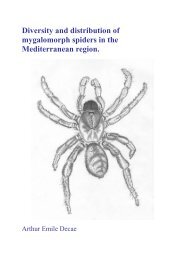PhD Reza Erfanzadeh 2009 - Ghent Ecology - Universiteit Gent
PhD Reza Erfanzadeh 2009 - Ghent Ecology - Universiteit Gent
PhD Reza Erfanzadeh 2009 - Ghent Ecology - Universiteit Gent
Create successful ePaper yourself
Turn your PDF publications into a flip-book with our unique Google optimized e-Paper software.
inundation (Egan & Ungar 2000; Wolters et al. 2005), grazing (Bakker & Ruyter 1981;<br />
Pehrsson 1988; van Wijnen et al. 1997; Schroder et al. 2002; Kleyer et al. 2003; Kiehl et al.<br />
2007) and soil factors (Tessier et al. 2000; Schroder et al. 2002; Tessier et al. 2003) (see<br />
details of these and other studies in the introduction of each of the following chapters). Very<br />
generally speaking, the results of these diverse studies showed that the impact of biotic and<br />
abiotic factors on vegetation succession often depends on the study area where the<br />
observations were made. Hence, general conclusions on succession determining process are<br />
difficult to make.<br />
1.3.1 Which species are able to be the first colonizers in a salt-marsh?<br />
The variables that control plant species co-occurrence (Gotelli & McCabe 2002) and<br />
primary succession (Kalliola et al. 1991; Walker et al. 2006; Shiels et al. 2008) are manifold<br />
and interactive (van der Valk 1992; Wiegleb & Felinks 2001).<br />
Initial substrates are colonized by a species through recruitment from viable seeds. Seed<br />
can be available by seed dispersal or from seed buried in the soil (Rand 2001). Seed (or<br />
diaspores in general) availability is only the first step needed to establish a population on a<br />
new substrate; seed availability alone only makes a species a member of the potential flora of<br />
the new site, not necessarily of its actual flora (Major & Pyott 1966). The probability of<br />
successful establishment from dispersed seed depends on several factors, i.e. seed production,<br />
seed dispersion and seed germination (van der Valk 1992). Unfortunately, these factors have<br />
never been examined together in detail in any single study. Many secondary factors affect<br />
each of these processes. For instance, seed production (the number of seeds produced by a<br />
plant or a population during a given growing season or year) depends on such factors as the<br />
age or size of the plant, the abundance of the population in the community or at a higher scale,<br />
environmental conditions during the previous and current growing season, availability of<br />
pollinators, predispersal predation and energetic trade-off between vegetative propagation and<br />
7










